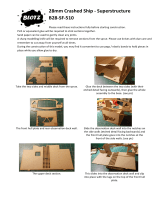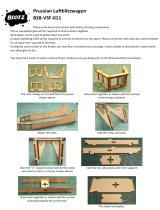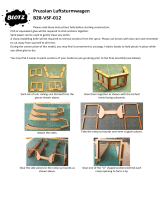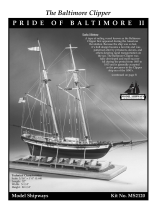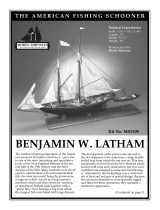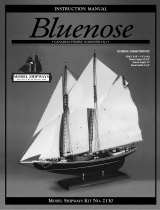Page is loading ...

Part of the bridge
Part of the bridge
Part of the bridge
Radar x 2
Part of the bridge x 2
Wire
•Fast-drying glue and wood
glue
•Metal file
•Sandpaper (grain no. 240
and no. 800)
• For metal: Super Glue Gel or
Two-part epoxy glue
•Craft knife
•Putty
•Double-sided adhesive tape
• Spatula and small brush
•Fretsaw
•Pliers
•Drill (diam. 0.5mm)
•Metal primer
•Wood primer
•Spray paint (battleship grey)
•Watercolour (silver)
Recommended tools and materials
6
Take piece 3, as shown in the
photo, and drill a hole of
0.5mm diameter and depth in
the centre. The operation is
easier if you cut a cross on the
point to be drilled with the craft
knife. Checking against Figure A
in Step 10, make a hole in pieces
1and 2, on the sides that fix to
the bridge.
5
After drying, paint the
cavities of the two pieces 4
with silver watercolour paint.
Apply a dab of paint with the
tip of the brush, being careful
not to let it drip.
4
When the metal primer is
completely dry, apply a
light and even coat of battleship
grey spray paint from a distance
of about 30cm. Let it dry
thoroughly. Spray the paint
several times from different
angles.
When using spray paint, ventilate the room well and follow
the instructions on the packaging.
When using metal primer, ventilate the room well and follow the
instructions on the packaging.
2
After this first smoothing,
continue with sandpaper grain
no. 800 on all pieces 1to 5, taking
care not to alter the original shape.
If there are any holes or dips on the
surface, correct them by applying
putty, and, after allowing to dry,
smooth with sandpaper.
3
Coat pieces 1to 5with the
metal primer, holding the can
at a distance of about 30cm. Fixing
them with double-sided adhesive
tape to a support will make the
operation easier.
1
Use the metal file to smooth
pieces 1to 5to remove any
irregularities. Where the file will not
reach, use the blade of the craft knife,
being careful not to cut your fingers.
PARTS OF THE BRIDGE
Parts of the bridge and the hull
Yamato: Step-by-step 85

12
After applying metal glue,
insert the wire protruding
from piece 3 in the hole made in
Step 10. Fix it so that piece 3has
the flat side face up and is parallel
to the bottom of the bridge.
7
After applying metal glue on
one end of piece 6, insert it
into the hole of piece 1. Let the
glue dry completely and, with the
pliers, cut piece 6so that it
protrudes 0.5mm from the hole.
Proceed in the same way with
pieces 2and 3. Keep what remains
of piece 6for later use.
10
Place piece 3on the top of
the bridge on the stern
side, aligning the bottom of the
piece with the top of the window.
Make a mark with wire
on the wall of the
bridge at the height
of piece 3.
11
At the spot marked in Step
10, drill a hole 0.5mm in
diameter and depth. The
operation is easier if you cut a
cross on the point to be drilled
with the blade of the craft knife.
9
At the centre of the upper
portion of piece 5just glued,
fix piece 4, facing the bow as
shown in the photo, with metal
glue.
14
As described in Step 13,
use metal glue to fix piece
2in the position shown in Figure
A, so that the lower side reaches
the top edge of the window. The
side with the small protrusion
must be on the top.
13
Following Steps 10 to 12,
use metal glue to fix piece 1
at the point indicated in Figure A,
so that the bottom reaches the
upper edge of the window. The
piece should be at a slight angle to
the bridge (Figure B). The side
with the small protrusion must
be on top.
15
Take the hull of the ship
and make a cut on the
surface of the bow block (Figure
C). Make a slight mark with the
fretsaw 10mm from the first
frame toward the bow. If you
have no fretsaw, use the craft
knife.
16
With the craft knife, trim
the surface from the edge
of the bow toward the mark made
in Step 15. Be careful not to
scrape the area too much when
going from the mark to the first
frame.
8
Take the command bridge and
insert piece 5in the recess
below the window sill on the upper
side of the bridge. If the recess is
too small, smooth the protruding
part of the piece, then apply metal
glue. Attach piece 5parallel to the
bottom of the deck. Similarly, fix
the other piece 5on the opposite
side.
THE HULL
A
B
80mm
0.5mm
higher than
the top edge
of the 1st frame
1st frame
C
Yamato: Step-by-step 86

18
Now, reinforce the interior
of the body of the ship.
Check carefully and apply fast-
drying wood glue to areas where
the strakes are in danger of falling
off. Thin the glue with water,
take a bit with the tip of the
brush, and apply lightly and
evenly on the parts to be
strengthened.
17
Complete the operation
by smoothing with
sandpaper grain no. 800. This is
easier if you use a sanding block.
21
Finally, smooth with
sandpaper grain no. 240,
levelling all the gaps. Although
the small ones can be corrected
with putty, it is better to use fast-
drying wood glue, since the putty
may shrink when dry, forcing
you to repeat the operation.
22
Spray wood primer on
the entire body of the
ship, from a distance of 30cm.
The operation is easier if you
turn the hull over on a rest, as
shown in the photo.
20
Carefully check the sides
and insert glue into any
cracks. Press the strip obtained in
Step 19 into the gaps, without
worrying about excess. When the
glue is completely dry, remove
the excess with the craft knife, as
shown in the photo, taking care
not to damage anything.
23
Once dry, smooth gently
with sandpaper grain no.
240, eliminating irregularities.
Brush off any dust produced and
apply a layer of putty over the
surface.
19
Next, deal with the sides.
In the previous steps you
eliminated unwanted projections.
At this stage you have to fill
unwanted cracks and cavities.
First, take a left-over strake and
make a strip by ‘planing’ it with
the craft knife.
24
Cover all dips or cracks
identified, covering even
the larger cavities well, using a
spatula. When the putty is dry,
smooth with sandpaper grain
no. 240, checking with your
fingers that you have smoothed
out hollows and bumps.
25
Remove any dust
produced in the previous
step with a dry cloth and spray
the primer over the entire hull of
the ship. You have now made
the hull of the ship fairly
smooth. Further improvement
comes in the next building
phase.
COMPLETED PIECES
PARTS OF THE BRIDGE
When using primer, ventilate the room well and follow the
instructions on the packaging. It is better to work outside,
weather permitting.
THE HULL
Yamato: Step-by-step 87

Signalling lamp x 2
Machine-gun (bottom) x 2
Machine-gun (top) x 2
Wire
Foredeck base
Foredeck
Piece 5 is made of photo-etched
brass, so avoid touching it with
your fingers as much as possible.
Prior to painting, it should be
degreased with a cleaning agent
such as a cellulose thinner.
• Fast-drying glue
• Metal file
• Sandpaper (nos 240, 400, 800)
• Craft knife
• Cutters
• Putty
• Double-sided tape
• Tweezers
• Small brush
• Metal primer
• For metal: Super Glue Gel or
Two-part epoxy glue
• Primer
• Spray paint (battleship grey)
• Watercolour (silver)
Recommended tools and materials
Signalling lamps, machine-guns,
foredeck and hull
31
With the metal file,
smooth the cut ends of
the pieces of wire. Following
Step 30, put the four pieces of
wire on the 5mm-wide piece of
strake and use the file to make
them all the same length.
30
Cut the wire 4with the
pliers to make four
pieces, each 5mm long. To
make the operation easier, take
a 5mm-wide piece of strake
and place one end of the wire
on it, fixing it with double-
sided adhesive tape, as shown
in the photo.
29
Where pieces 1to 3
are uneven, or have
hollows, remedy this by
applying putty with the tip
of the craft knife. When the
putty is completely dry,
smooth the pieces with
sandpaper grain no. 800.
27
Smooth pieces 1to 3using
sandpaper grain no. 800. Be
careful not to smooth the hollow or
protruding areas.
28
Where it is difficult to work
with sandpaper, it is better to
use the tip of the craft knife, taking
care not to damage other parts or
hurt your fingers with the tip.
26
Prepare pieces 1to 3, using
the metal file to eliminate all
irregularities. Make sure that the
bottom surface of 1is perfectly
smooth.
SIGNALLING LAMPS AND MACHINE-GUNS
Yamato: Step-by-step 88

37
Take the command bridge
and fix the two pieces 1 with
the metal glue. Attach the spars
that project obliquely on both
sides in the middles of the upper
surface, aft of the command deck.
The signalling lamps must face out
to the right and left sides
respectively.
32
Place piece 3as shown in
the photo and, with the
fast-drying glue, fix two pieces of
wire in the grooves, one at a time.
You have just made the top of a
machine-gun. Now make another.
35Lightly spray pieces 2and
the upper parts of the
machine-guns with battleship grey
from a distance of about 30cm.
When the paint is dry, spray again
from a different angle. Repeat this
several times, changing direction
each time.
36
When the spray paint is
completely dry, paint the
‘bulbs’ of pieces 1with silver
watercolour. Put a small amount
on the tip of a brush and be sure
to paint only the required parts,
taking care not to drip anywhere
else.
34
When the metal primer is
completely dry, spray
pieces 1battleship grey from a
distance of about 30cm. When
the paint is dry, spray again from
a different angle. Repeat this
several times, changing direction
each time.
39
Fix a machine-gun starboard
of the bridge, on the
intermediate base, with metal glue.
Assemble it on the ledge inside the
base, turning the barrels of the
machine-gun outwards. Similarly,
fix the other machine-gun on the
intermediate port base.
38
Take a piece 2, as shown in
the photo, and with metal
glue fix the upper part of the
machine-guns. You must insert the
uneven part of the left side of the
base of the upper part of the
machine-gun in the projection on
the right side of piece 2. Repeat the
operation for the other machine-gun.
40
Position the hull as shown in
the photo. Rest piece 6on
the bow, aligning it with the end of
the bow block and inserting the
edges in the slope between the bow
block and the strakes. It is possible
that the piece will not match the
strakes and cannot be glued
properly.
41
Take piece 6and trim it
where it does not fit with the
strakes. We suggest trimming both
ends on the stern side so as to make
them slant. First, pare them roughly
with the craft knife, but take care not
to overdo it and make a gap between
piece 6and the strakes.
When using the metal primer, ventilate the room well and follow
the instructions on the packaging.
When using spray paint, ventilate the room well and follow the
instructions on the packaging.
33Paint pieces 1and 2and
the upper parts of the
machine-guns. First, spray metal
primer evenly on all parts from a
distance of about 30cm. It is easier
if you fix the pieces on a strip of
wood with double-sided adhesive
tape.
THE FOREDECK
Yamato: Step-by-step 89

43
After degreasing, evenly
spray piece 5with the
metal primer, from a distance of
about 30cm.
42
After this initial scraping,
finish with sandpaper
grain no. 240. It is advisable to
use a sanding block, made in the
usual manner.
46
Near where the planes
are docked at the stern,
the area where strakes, side walls,
rear deck and metal parts all
meet, is where cracks can easily
occur. Do not forget to apply
putty and cover them
completely.
47
When the putty is completely
dried, smooth the entire
surface of the hull with sandpaper
grain no. 240 and/or grain no. 400.
Take special care over the stern and
bow, creating natural-looking curves.
We suggest that you smooth the
rounded protrusions of the base on
the bow as if creating a sphere.
45Check the hull closely,
and you will notice there
are still some small irregularities.
Apply putty on all the hollows
and gaps you see. Putty the
bottom of the hull, too,
including small crevices such as
joints and graining in the
strakes.
48
If the sides form a single
straight line, the finish after
painting will show it at its best. Use
sandpaper folded in half, and make
sure that the edge comes out
perfectly.
44Where the primer is
completely dry, give a
light coating of battleship grey
spray paint from a distance of
about 30cm. When dry, spray
again from a different angle.
Pieces 5and 6will be mounted
later, so store them carefully.
49
After removing the dust
from the sandpapering with
a dry cloth, spray the entire surface
of the hull with the primer.
50
When the coating is dry,
recheck the hull, and if there
are still irregularities, repeat the
operations described in Steps 45 to
49. Repeat several times until all
the tiny irregularities, and all the
cracks, are eliminated and the lines
are perfectly smooth and curved.
COMPLETED PIECES
When using spray paint, ventilate the room well and follow the
instructions on the packaging.
When using primer, ventilate the room well and follow the
instructions on the packaging.
When using the metal primer, ventilate the room well and
follow the instructions on the packaging.
THE HULL
THE HULL
PARTS OF THE BRIDGE
FOREDECK
Yamato: Step-by-step 90

Deck
Deck
Deck planking x 10
Machine-gun (top) x 4
Machine-gun (bottom) x 4
Wire
• Fast-drying glue
• Wood glue
• For metal: Super
Glue Gel or Two-part
epoxy glue
• Metal file
• Sandpaper (grain
no. 240 and no. 800)
• Adhesive tape
• Double-sided
adhesive tape
• Pliers
• Putty
• Drill (diam.1.2mm )
• Pliers
• Set-square
• Craft knife
• Pencil
• Metal primer
• Spray paint for models
(battleship grey)
Recommended tools and materials
Machine-guns and the foredeck
56
Take a 5mm-wide strake
and make four holes
1.2mm in diameter and 1mm in
depth. Insert the projecting parts
of pieces 5in them and fix
firmly. Now they are ready to be
painted.
55
Place piece 4as shown in
the photo and, with fast-
drying glue, fix three pieces of
wire in the grooves, one at a
time. Make another three tops of
the machine-guns.
54
Smooth the ends of the
wire with the metal file.
Following Step 53, arrange the
12 pieces of wire on the 5mm-
wide strake and, with the metal
file, make them all exactly the
same length.
52
Where the sandpaper cannot
reach, use the tip of the craft
knife. Be careful not to damage
other parts or cut your fingers. If
there are cracks or dips in the
surface, correct them with putty.
Once dry, smooth with sandpaper
grain no. 800.
53
With the pliers, make 12
5mm-long pieces of wire 6.
Do this by taking a 5mm-wide
strake and, as shown in the photo,
placing one end of the wire on it
and fixing it with double-sided
tape.
51
Smooth pieces 4and 5, using
the metal file to remove
irregularities. After an initial filing,
smooth with sandpaper grain no.
800, taking care not to damage the
original shape.
MACHINE-GUNS
Yamato: Step-by-step 91

62
With the craft knife,
remove 1mm from one
end of the stack of planks made
in Step 60. Make sure that the
blade of the craft knife is vertical.
57
Paint pieces 5and the
upper parts of the machine-
guns. First, spray the metal primer
evenly from a distance of 30cm.
To do this, the upper parts of the
machine-guns can be fixed with
double-sided adhesive tape.
60Remove any roughness
from the decking planks 3,
rubbing gently with sandpaper
grain no. 240. If they have
different widths, work them with a
sanding block, as shown in the
photo. This will be easier if you fix
the ends of the planks with wood
glue (Figure A). Be careful not to
alter the original shape.
61
Stack five pieces 3, binding
them together with
adhesive tape. Before doing so,
however, touch the glue with
your fingers to reduce its
stickiness. Make another bundle
of five pieces 3.
59
Fix the upper parts of the
machine-guns on pieces 5
with metal glue. Place them as
shown in the photo and make the
upper parts of the machine guns
stick to the projections of each
piece 5. The machine-guns are
now ready. Store them with care
for use later.
64
Take the hull of the
ship and place the
foredeck that you assembled
earlier. Insert piece 2along the
line shown in the photo. The
side with the double line must
be face up. This piece must be
glued and mounted with
precision on the frames.
63
Cut one bundle of planks
into two lots of 10cm and
one lot of 5cm, thus obtaining
ten slats of 10cm and five of
5cm. Then remove the tape.
Repeat with the remaining five 3
pieces, finishing with a total of
20 slats of 10cm and ten slats of
5cm.
65
If piece 2extends beyond
the frames, smooth the
edges by scraping with the craft
knife and then rubbing with
sandpaper grain no. 800, keeping
the symmetry of the two sides in
relation to the double line. Be
careful not to smooth too much
and create gaps between the piece
and the strakes.
66
Rest piece 1as shown in
the photo, keeping the side
with the double line face up.
Firmly glue piece 1to piece 2. If it
proves difficult to insert, deal with
it as in Step 65. After fixing all the
pieces, remove the foredeck, and
pieces 1and 2from the body of
the ship.
When using the metal primer, ventilate the room well
and follow the instructions on the packaging.
When using spray paint, ventilate the room well and follow
the instructions on the packaging.
58When dry, spray a light
coat of battleship grey
paint from a distance of about
30cm. Once dry, spray again
from a different angle. Repeat
several times, changing angles and
taking care not to block in the
original details.
THE FOREDECK
A
To be stuck temporarily
with wood glue.
Foredeck
Yamato: Step-by-step 92

68
Fix the decking prepared
in Step 63 on top with
wood glue. Apply drops of glue
at intervals on one side only and
spread it evenly with the tip of a
finger. Take care not to apply too
much glue as this will make the
painting, which will be done
later, more difficult.
67
Fix piece 1to 2with
wood glue by aligning the
double line. The foredeck is now
complete.
71
Glue another 10cm slat
on the double line
abutting the left edge to the
decking fixed in Step 69. The
right edge of this slat should go
5mm beyond the deck.
72
Fix a 5cm slat below the
one fixed in Step 69,
aligning the right edge with the
left reference line. It does not
matter if the left edge protrudes
beyond the deck. To the right of
the decking just glued, fix
another 10cm one, aligning the
right end with the right
reference line.
70In the area to the right
edge of the decking just
glued, draw a line perpendicular
to the double line and take it as
the baseline. Then draw a
parallel line 5cm away from the
baseline, both right and left.
73
Below the decking fixed in
Step 71, glue two 10cm
slats, aligning them horizontally
to the baseline.
69Place the foredeck, as
shown in the photo, and
glue a 10cm slat on the double
line, making it go beyond the left
edge by 1mm.
74
Following Steps 71 to 72,
fix the remaining
decking, alternating the 5cm
decking with the 10cm decking,
as shown in the photo.
75
On the opposite side of
the central line, fix six
more columns of decking as
described in Steps 71 to 74.
COMPLETED PIECES
THE FOREDECK
MACHINE-GUNS
5cm
5cm
Baseline
Align with the
baseline.
Yamato: Step-by-step 93

Decking
Deck planking x 20
Machine-gun (top) x 4
Machine-gun (bottom) x 4
Wire
• Fast-drying glue
• Wood glue
• For metal: Super Glue Gel or
Two-part epoxy glue
• Metal file
• Sandpaper (grain no. 240 and
no. 800)
• Craft knife
• Pliers
• Putty
• Tweezers
• Double-sided adhesive tape
• Adhesive tape
• Metal primer
• Spray paint (battleship grey)
Recommended tools and materials
Machine-guns and decking
81
Paint pieces 4and the upper
parts of the machine-guns.
First, spray the metal primer and
then spray the battleship grey paint.
To do this, the 4pieces can be
inserted in holes bored in a wooden
slat and the upper parts of the
machine-guns attached with
double-sided adhesive tape.
80
Place piece 3as shown in
the photo and, with metal
glue, fix three pieces of wire in the
grooves, one at a time. You have
made the top of a machine-gun.
Make another three.
79
Smooth the ends of the
wire with the metal file.
Following Step 78, arrange the 12
pieces of wire on the 5mm-wide
strake and, with the file, make
them all exactly the same length.
When using spray paint, ventilate the room well and
follow the instructions on the packaging.
77
If pieces 3and 4have
hollows and dips on the
surface, correct them by applying
putty, using the tip of the craft
knife. When the putty is completely
dry, finish the pieces using
sandpaper grain no. 800.
78
With the pliers, cut 12
5mm-long pieces of the wire.
Do this by taking a 5mm-wide piece
of strake and, as shown in the
photo, match up one end of the
wire and fix with double-sided
adhesive tape.
76
Smooth pieces 3and 4using
the metal file to remove
irregularities, then rub them with
sandpaper grain no. 800, taking care
not to damage the original shape.
Where the sandpaper does not reach,
use the tip of the craft knife.
MACHINE-GUNS
Yamato: Step-by-step 94

87
To the right of the
plank glued in Step 86,
fix a 10cm one. Align the
right edge to the reference line
on the right.
82
With the metal glue, fix the
upper parts of the machine-
guns on pieces 4. Place them as
shown in the photo and get the
upper parts of the machine guns to
stick to the projections of each
piece 4. The machine-guns are now
ready; store them with care for use
later.
85With the craft knife, remove
1mm from one end of the
stack of planks made in Step 84 to
align the ends. Divide the stacks of
planks into two lots of 10cm and one
lot of 5cm, thus obtaining ten slats of
10cm and five of 5cm. Remove the
tape. Repeat with the remaining five
pieces 2, finishing with a total of 40
slats of 10cm and 20 of 5cm.
86
Take the foredeck assembled
so far, as shown in the photo.
Under the lowest plank, in the
seventh column counting from the
centre to the port side, glue a 5cm
piece of decking. Make the right
edge align with the reference line on
the left, and allow it to protrude a
little to the left. It must also stick to
the plank above.
84
Stack five pieces 2, keeping
them together with adhesive
tape. Before doing so, however, touch
the adhesive with your fingers to
reduce its stickiness.
89
Following Steps 86 and
87, fix a column
consisting of a 5cm plank and
a 10cm plank, and following
Step 88 glue a column
consisting of two 10cm
planks. Repeat the two
procedures alternately, up to
gluing a 13th column.
88
Under the column of
the decking glued in
Step 87, fix the plank of the
eighth column. Attach two
10cm slats, making them align
with the central reference line.
When you glue the right
decking, check the alignment
with a ruler.
90
Following Steps 86 to
89, glue the
corresponding decking on the
opposite side. Arrange the
deck as shown in the photo,
and counting from the
decking of the centre, fix two
10cm slats in the 14th
column, aligning them with
the central reference line.
91
Fix a 10cm plank in
the 15th column,
aligning the right end with
the reference line on the right
and making it protrude to the
left. At the 16th column, fix a
5cm and a 10cm plank (with
the 5cm to the left), aligned
with the central reference
line.
83Remove any roughness from
the planks 2, rubbing gently
with sandpaper grain no. 240. If
they have different widths, work
them with a sanding block, as shown
in the photo. The operation will be
easier if you temporarily fix the ends
of the planks with wood glue (Figure
A). Be careful not to alter the
original shape.
THE DECKING
A
Temporary fixing
with wood glue.
Make it align
with the central
reference line
Yamato: Step-by-step 95

93
In the 19th column, fix a
5cm plank. Align the right
end with the reference line on the
right. In the 20th column, fix a
10cm slat, aligning the right end
with projections on the right side
of the slats fixed so far. Do not
glue a 21st column.
92
In the 17th column, fix a
10cm plank. Align the
right end with the right reference
line. In the 18th column, fix a
10cm plank, aligning the left end
with the central reference line.
The left side of the deck visible
beyond the reference line will be
dealt with later.
96
Take the deck, as shown in
the photo, and equalize the
length of the projection of the
decking with a sanding block. Be
careful not to exert too much
force, which could cause the slats
to break or detach.
97
Take the hull of the ship
and, after setting the
foredeck on it, place piece 1,
keeping the side with the double
line face up and inserting the piece
under the protruding decking of
the foredeck. The piece, which
must be mounted with accuracy on
the framework, must be fixed well.
95When the glue is
completely dry, turn over
the deck and place it as shown in
the photo. With the craft knife,
cut the decking protruding to the
right, left and bottom of the deck.
Do not cut the decking that
protrudes at the top.
98
If it does not fit well,
adjust piece 1, smoothing
both sides. First trim them with
the craft knife, then smooth them
with sandpaper grain no. 800.
Keep the symmetry of the two
sides in reference to the double
line. Smooth gently to avoid
creating gaps between the piece
and the strakes.
94Cover the deck visible to
the left of the 18th column
with a piece of leftover plank.
Since the surfaces to stick are very
small, press the plank with the tip
of a finger until the glue is dry.
Keep the other decking. Following
the procedures described in Step
90 onwards, fix the other side with
its respective planks.
99
Adjust the shape, remove
the decking and then stick
piece 1to the foredeck by
attaching it with double-sided
adhesive tape. First, apply the
double-sided tape to the edge of
piece 1, then cut the excess tape
with the craft knife, as shown in
the photo.
100
Attach the part of piece
1that has the adhesive
tape to the forward deck and
apply glue on the back of the
decking protruding from the
forward deck, inserting them
under piece 1. Continue by
aligning the central axis of the
foredeck with the two central lines
of piece 1.
COMPLETED PIECES
DECKING
MACHINE-GUNS
Align the right ends
Leave the
decking
sticking
out on
this side.
Yamato: Step-by-step 96
/
